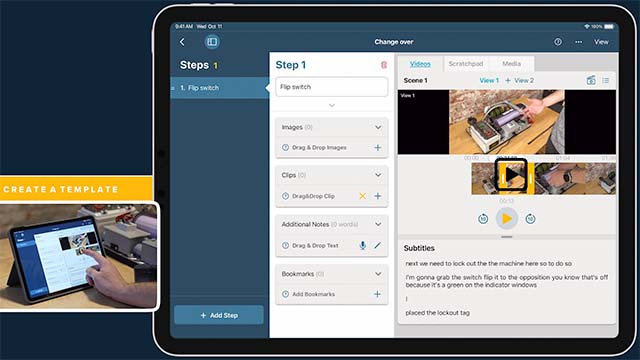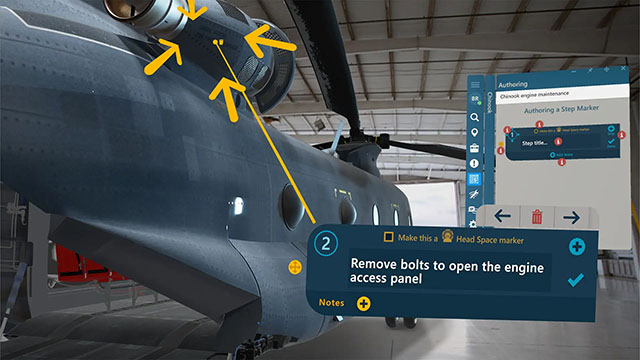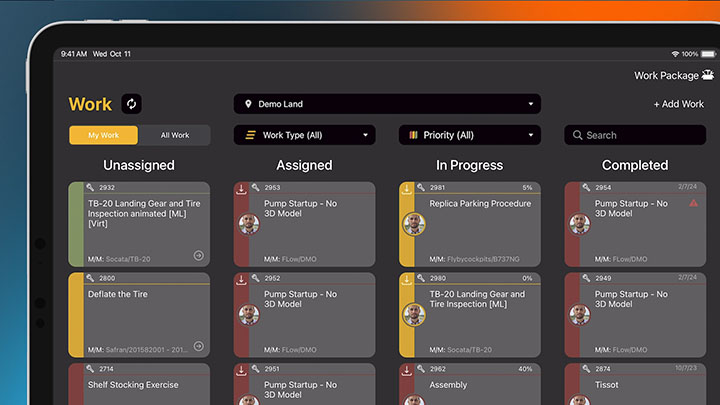What are Faults
Faults are a function within Manifest that allows users to quickly indicate an issue with an Asset or a Job step. This feature is well suited for inspection procedures or any case where a user may need to indicate a Fault in an Asset or within a Job. When a Fault is added, it is recorded as its own data entry, and associated to the Asset which it was added.
Faults can be added using any Manifest platform by anyone with either Operator, Author, or Admin permissions. When a user adds a Fault, they will be required to enter a Fault description and will have the option of adding Fault Notes (configurable by the Administrator of the Manifest Domain) to add details about the issue. Faults added through an AR enabled platform (Manifest 3D or Manifest iPadOS applications) can be spatially placed near the issue so they will display at the location of the Fault for anyone viewing Faults in AR over a specific Asset.
If an Asset, Location, or Job has an Open Fault – a red triangle icon will display over the related listing to alert users of the issue.
Fault Note Configuration
Each Manifest domain may configure its own settings for Fault Notes. Fault Note Settings may be managed to limit the Note options available, require a specific type of Note when a Fault is added, or add custom lists for users to select from when recording a Fault.
This allows organizations to collect consistent data related to Faults, apply existing processes for Fault documentation, and set requirement rules for specific note types as needed.
Setting Note Type Requirements
- *Note: This is only possible from the Web application and may only be accessed and edited by a user with the role of Admin
- From the Main Menu bar, navigate to the Faults window
- Select Edit Types of Notes from the Faults Pane in the upper right-hand corner

- Within the Fault Notes Settings pop-up window, configure the desired options and requirements:

- Select or unselect each Note type checkbox to indicate which Note types should be available for Faults
- To require a specific Note type when a Fault is added, select the ‘Required’ toggle to turn on this requirement
- To add a Custom Value list as a Note type for Faults, select the dropdown menu for the Custom note option and select or add the desired value list (this will prompt the user to select from a predefined list of options)
- Once all desired settings have been established, select Save
- Fault Note options and requirements will now be applied to all Faults added in the domain
Adding Faults
Using any Manifest application, Faults can be added during a Job or directly to an Asset. Using the Manifest Web application, Faults can also be added via the Faults window. For instructions on the various paths for adding Faults, please see below.
Manifest 3D Application
Faults can be added via the following methods using the Manifest 3D application:
- During a Job, select the Add Fault button from the top of the Step Marker to add a Fault to a Job Step. The Job ID and Job Step will automatically be recorded with the Fault and a Fault icon will be displayed on that Step in the Job Checklist
- From the desired Asset, navigate to the Asset Detail window and select the Faults tab. This will list all Faults recorded for that Asset. To record a new Fault for the Asset, select the green plus icon in the lower left-hand corner
Adding a Fault using the Manifest 3D application:
- Select Add Fault
- An AR Fault Marker will automatically render in the users’ field of view

- An AR Fault Marker will automatically render in the users’ field of view
- To spatially position the Fault, select + hold + and drag the AR Fault Marker to the desired location (note: a Tip window will illustrate these instructions the first time a Fault is added using the 3D application)

- To add lines from the Fault Marker to the location of the issue, select + hold + and drag the white dot at the top of the Fault Marker to the desired end point. This will add a leader line. Repeat this process to add multiple leader lines.
- Enter the Fault description
- Select Add Notes to display the list of Fault Note options available (required notes will be denoted with a yellow ‘Required’ label)
- Select the desired Note type and follow the instructions to save each Note
- To save the Fault, select the green check icon
Manifest Web Application
Faults can be added via the following methods using the Manifest Web application:
- During a Job, select the Add Fault button from the Job Step action buttons on the right. The Job ID and Job Step will automatically be recorded with the Fault and a Fault icon will be displayed on that Step in the Job Checklist.
- From the Assets window, select the Menu option Assets. Find the desired Asset and expand for the Asset details and options. From the bottom menu of the Asset Detail select Faults. To record a new Fault for the Asset, select the plus icon in the right-hand corner
- From the Faults window, select the + Fault button in the upper left-hand corner
Adding a Fault using the Manifest Web application:
- Select Add Fault
- Note: when adding a Fault from the Faults window the user will be required to manually select the Location and Asset the Fault should be recorded
- Enter the Fault description
- Select Add Notes to display the list of Fault Note options available (required notes will be denoted with a yellow ‘Required’ label)
- Select the desired Note type and follow the instructions to save each Note
- Select Add Fault

Manifest iPadOS Application
Faults can be added via the following method using the Manifest iPadOS application:
- During a Job, select the Add Fault button from the Job Step action buttons on the right-hand side of the screen. The Job ID and Job Step will automatically be recorded with the Fault and a Fault icon will be displayed on that Step in the Job Checklist.
Adding a Fault using the Manifest iPadOS application:
- Select Add Fault from the right-hand side of the Job pane
- Enter the Fault description
- Select the desired (or required) Note type and follow the instructions to save each Note
- *Note: required notes will be denoted with a yellow ‘Required’ label
- Select Save

Adding Work to a Fault
Users have the option to create related Work to a Fault. Work may be Tasks that are required to resolve the Fault such as ordering Parts, requesting a specialist to inspect the issue; or Jobs that are generated from existing procedure Templates. Associating Work to a Fault can assist users in tracking the status and history for resolving Faults.
Manifest 3D Application
To Add Work to a Fault in the 3D application, first locate the desired Fault on the Asset (this can be done by navigating to the Asset Detail Faults tab or by selecting Show Fault in a Job with a Fault)
- From the Fault Marker or Fault Listing, select Add Job or Add Task

- A new window will appear prompting for the required information
- Creating a Job will prompt the user to select from a list of available Templates for the related Asset

- A Task will prompt the user to enter a description

- Creating a Job will prompt the user to select from a list of available Templates for the related Asset
- Set the Priority of the Work item by selecting to corresponding colored circle (green = Low, yellow = Medium, red = High)
- Once all required data has been entered, a green check button will display in the lower right-hand corner
- Select the green check to add the Work item
- The Work item will be associated with the Fault and may be opened from the Fault by selecting the corresponding button under Work
Manifest Web Application
To Add Work to a Fault in the Web application, first locate the desired Fault (this can be done by navigating to the Faults window from the Main Menu or by selecting the Fault in a Job Step).
- From the Fault, select Add Work
- In the Faults window, this can be found by selecting the three dots to the right of the Fault listing to open the options menu

- In a Job, from the Job Step the Fault was recorded select Show next to the Fault title to expand the Fault details

- In the Faults window, this can be found by selecting the three dots to the right of the Fault listing to open the options menu
- A new window will open
- Select the desired Work item type (Job or Task) from the top tab
- Enter the required information
- Creating a Job will prompt the user to select from a list of available Templates for the related Asset.
- A Task will prompt the user to enter a description.
- Set the Priority of the Work item
- Select Create

- The Work item has been added and will be associated with the Fault
Manifest iPadOS Application
To Add Work to a Fault in the iPadOS application, first locate the desired Fault (this can be done by selecting the Fault in a Job Step).
- From the Fault, select + Add Work
- In a Job, from the Job Step the Fault was recorded select the Fault title to expand the Fault details

- In a Job, from the Job Step the Fault was recorded select the Fault title to expand the Fault details
- A new window will open
- Select the desired Work item type (Job or Task) from the top tab
- Enter the required information
- Creating a Job will prompt the user to select from a list of available Templates for the related Asset
- A Task will prompt the user to enter a description
- Set the Priority of the Work item
- Select Add
- The Work item has been added and will be associated with the Fault
Resolving Faults
When an issue has been addressed and no longer requires attention, users may resolve the associated Fault. This will update the red Fault icon to a gray triangle with a green checkmark. The status of the Fault will be updated to Resolved to indicate the issue is closed. Faults can be resolved using any Manifest platform by anyone with either Operator, Author, or Admin permissions.
Manifest 3D Application
To Resolve a Fault in the 3D application, first locate the desired Fault on the Asset (this can be done by navigating to the Asset Detail Faults tab or by selecting Show Fault in a Job with a Fault)
- From the Fault Marker or Fault Listing, select Resolve
- The Fault will automatically update to a gray icon with a green check and display the user, date & time the Fault was resolved

- The Fault will automatically update to a gray icon with a green check and display the user, date & time the Fault was resolved
- To Reopen a Fault select the button for Reopen Fault
- This may only be done by the user who resolved the Fault
Manifest Web Application
To Resolve a Fault in the Web application, first locate the desired Fault (this can be done by navigating to the Faults window from the Main Menu or by selecting the Fault in a Job Step).
- Locate the Fault, select Resolve Fault
- In the Faults window, this can be found by selecting the three dots to the right of the Fault listing to open the options menu

- In a Job, from the Job Step the Fault there will be a Resolve Fault button in the right-hand pane of the Job window

- The Fault will automatically update to a gray icon with a green check and display the user, date & time the Fault was resolved
- In the Faults window, this can be found by selecting the three dots to the right of the Fault listing to open the options menu
- To Reopen a Fault select the button for Reopen Fault (This may only be done by the user who resolved the Fault)
Manifest iPadOS Application
To Resolve a Fault in the iPadOS application, locate the Job with the Fault.
- Open the completed Job with the Fault
- Select the Job Step where the Fault was recorded
- From the Job Step there will be a Resolve Fault button in the right-hand pane of the Job window

- From the Job Step there will be a Resolve Fault button in the right-hand pane of the Job window
- Select Resolve Fault
- The Fault will automatically update to a gray icon with a green check and display the user, date & time the Fault was resolved
- To Reopen a Fault select the button for Reopen Fault (This may only be done by the user who resolved the Fault)




